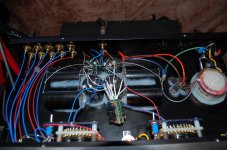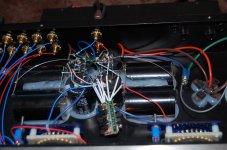And yes i'd say the caps are all for the power supply. I believe the designer claims that more power supply capacitance always sounds better.
I don't think the Burson is a FET design.
On the perils of opamp swapping 🙂
http://www.diyaudio.com/forums/anal...u-have-checked-see-its-stable-havent-you.html
I said on that thread that I would link it to any about opamps.
On the perils of opamp swapping 🙂
http://www.diyaudio.com/forums/anal...u-have-checked-see-its-stable-havent-you.html
I said on that thread that I would link it to any about opamps.
That is scary 😱
Those caps look to be wired across the main electroylitics... perhaps best we don't even go into that. The circulating currents in that "square" of wires will be really high believe it or not, just for an instant each mains cycle as the AC voltage "tops off" the reservoir caps to replace charge lost suppying the opamp. That means the grounding points are ultra critical to avoid hum.
Would have had to have seen the original IC fitted and how they connected it.
I'm speechless tbh...
Those caps look to be wired across the main electroylitics... perhaps best we don't even go into that. The circulating currents in that "square" of wires will be really high believe it or not, just for an instant each mains cycle as the AC voltage "tops off" the reservoir caps to replace charge lost suppying the opamp. That means the grounding points are ultra critical to avoid hum.
Would have had to have seen the original IC fitted and how they connected it.
I'm speechless tbh...
Lol. Sorry to hear that. I tend to have that effect on people. This was not intended as a permanent solution. There was no other way of doing it. No room on top and the long wires caused even more noise. As messy as it looks it actually shouldn't be hard to bend the wires back into original position. They are still in the same order just spaced apart further.
That is scary 😱
Those caps look to be wired across the main electroylitics... perhaps best we don't even go into that. The circulating currents in that "square" of wires will be really high believe it or not, just for an instant each mains cycle as the AC voltage "tops off" the reservoir caps to replace charge lost suppying the opamp. That means the grounding points are ultra critical to avoid hum.
Would have had to have seen the original IC fitted and how they connected it.
I'm speechless tbh...
I'm pretty speechless too, but, I've seen other BC products like that, with globs of silicone/caulk/glue.
The silicone/caulk/glue facilitates point to point. Whatever works I guess.😕
That preamp is supposed to be a point to point IC opamp design, so I'm guessing that the original PDIP opamps were just "floating".
That preamp is supposed to be a point to point IC opamp design, so I'm guessing that the original PDIP opamps were just "floating".
That's part of it for sure.
And then you look how much these things cost...
And those foil caps. The inductance of the wires negates there effectiveness at hf
sardonx... would you be able to wire a new DIP opamp as it was before using the same wiring points as original.
That might be the best solution, at least to work back and make sure it is still OK.
Morning Bonsai...
Absolutely... when you see the quality of product and PCB some folk on here can turn out.
Used to have to work a lot on budget gear in the past such as <£$150 music centres... all glue and sellotape I used to call them 🙂
Absolutely... when you see the quality of product and PCB some folk on here can turn out.
Used to have to work a lot on budget gear in the past such as <£$150 music centres... all glue and sellotape I used to call them 🙂
That's part of it for sure.
And then you look how much these things cost...
And those foil caps. The inductance of the wires negates there effectiveness at hf
sardonx... would you be able to wire a new DIP opamp as it was before using the same wiring points as original.
That might be the best solution, at least to work back and make sure it is still OK.
We're on the same page.
I would suggest wiring a DIP8 socket in place like the original op-amp was. Makes is easier for experimenting.
I might be willing to donate a LME49880 to the cause here. It's mounted on a DIP8 adapter with a thermal pad.
I might be willing to donate a LME49880 to the cause here. It's mounted on a DIP8 adapter with a thermal pad.
Thanks for the offer theAnonymous1 🙂 Mooly, I did just that, I soldered a good quality dip socket in and plugged in two opa627's in, which are sitting in their own dual to single adapter. Works perfectly. No noise, just music. I have to say though, I don't like the sound as much as the burson. I know the 627's are supposed to be the cat's ***, and I know they are when implemented correctly. They sound nice, but definitely colored and take away some dynamics and transparency plugged into here.
Right now i'm listening with the pre out of the loop, straight out of the audio interface which has a volume control and nothing beats the transparency. I just wanted that extra little bit out of the preamp but it's gonna be tough to get that i think. I may further experiment with different opamps in the pre, but at this point i'm thinking of building a simple yet musical pre inside the existing enclosure as i'm not gonna get what i payed for the blue circle if i resell and it's no longer a 'blue circle' as i've messed with it. The case is so cool though 🙂 But like you guys say, i think it went for $2000 new 5 or 6 years ago but i'm not gonna get into the value discussion 🙂 I picked it up for a quarter of that and i think it was a good deal. The Shallcos, the case, and transformer are worth at least half of that to me. Now.. can anyone suggest a simple and easy to build preamp that sounds musical?
Right now i'm listening with the pre out of the loop, straight out of the audio interface which has a volume control and nothing beats the transparency. I just wanted that extra little bit out of the preamp but it's gonna be tough to get that i think. I may further experiment with different opamps in the pre, but at this point i'm thinking of building a simple yet musical pre inside the existing enclosure as i'm not gonna get what i payed for the blue circle if i resell and it's no longer a 'blue circle' as i've messed with it. The case is so cool though 🙂 But like you guys say, i think it went for $2000 new 5 or 6 years ago but i'm not gonna get into the value discussion 🙂 I picked it up for a quarter of that and i think it was a good deal. The Shallcos, the case, and transformer are worth at least half of that to me. Now.. can anyone suggest a simple and easy to build preamp that sounds musical?
I would still say to try some different opamps. Nothing exotic. Try the OPA2134 dual.
Something like this really needs a scope hanging on the output to check it is stable.
Looking at the pics it appears there is a series resistor to the output sockets... that's good. It also looks DC coupled. That means no input coupling caps, no caps in the opamp feedback return network and no output coupling cap. If so then we stick with FET opamps as mentioned before.
The OPA627 is a real high performance (as in outside of the audio field) and may not be ideal in a set up liike this.
If there is any doubt on stability then it's worth adding (assuming a non inverting opamp configuration) a small cap of around 4.7 to 10 pf across pins 1 and 2 and pins 7 and 6 to help guarantee total stability.
Try the opamps... and give it time listening to it. It won't change through use but your expectation will. Forget what is actually in there and just listen.
Something like this really needs a scope hanging on the output to check it is stable.
Looking at the pics it appears there is a series resistor to the output sockets... that's good. It also looks DC coupled. That means no input coupling caps, no caps in the opamp feedback return network and no output coupling cap. If so then we stick with FET opamps as mentioned before.
The OPA627 is a real high performance (as in outside of the audio field) and may not be ideal in a set up liike this.
If there is any doubt on stability then it's worth adding (assuming a non inverting opamp configuration) a small cap of around 4.7 to 10 pf across pins 1 and 2 and pins 7 and 6 to help guarantee total stability.
Try the opamps... and give it time listening to it. It won't change through use but your expectation will. Forget what is actually in there and just listen.
- Status
- Not open for further replies.
- Home
- Source & Line
- Analog Line Level
- Upgraded opamp in preamp and now there is a hum/buzz

